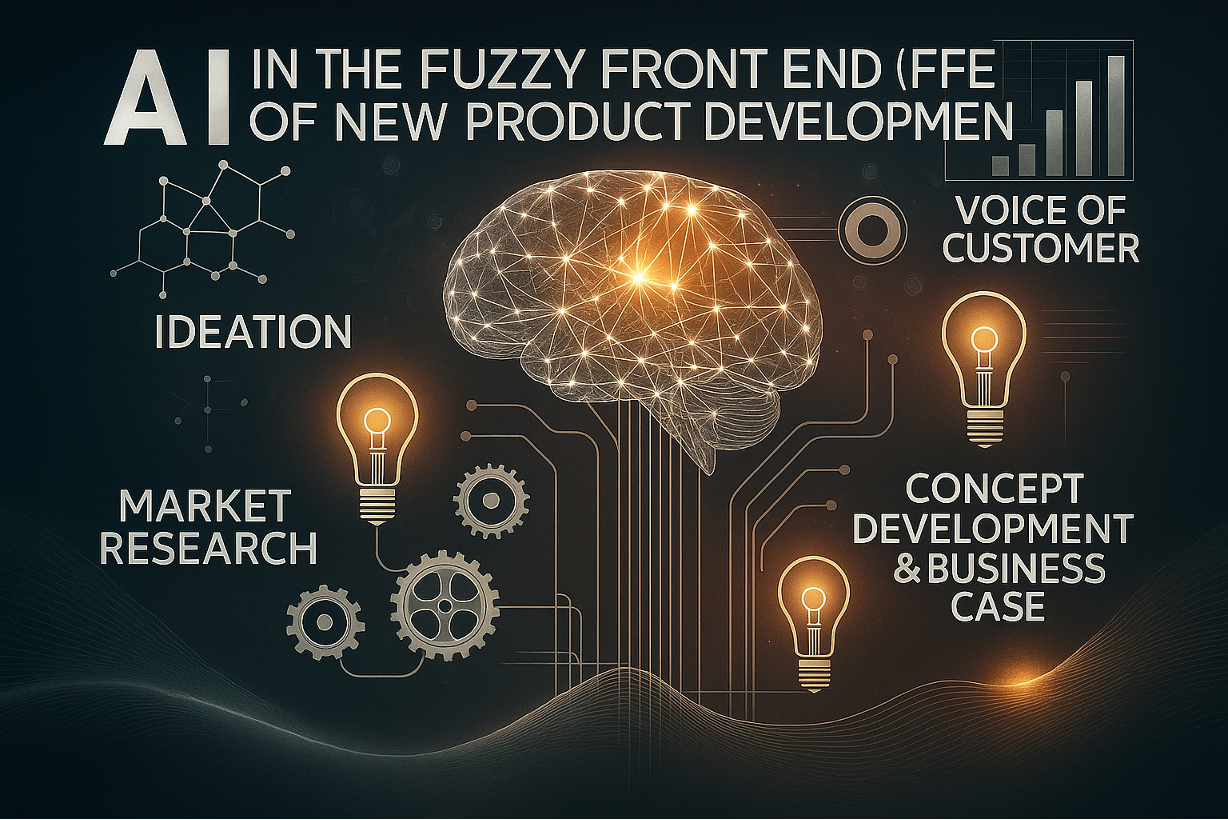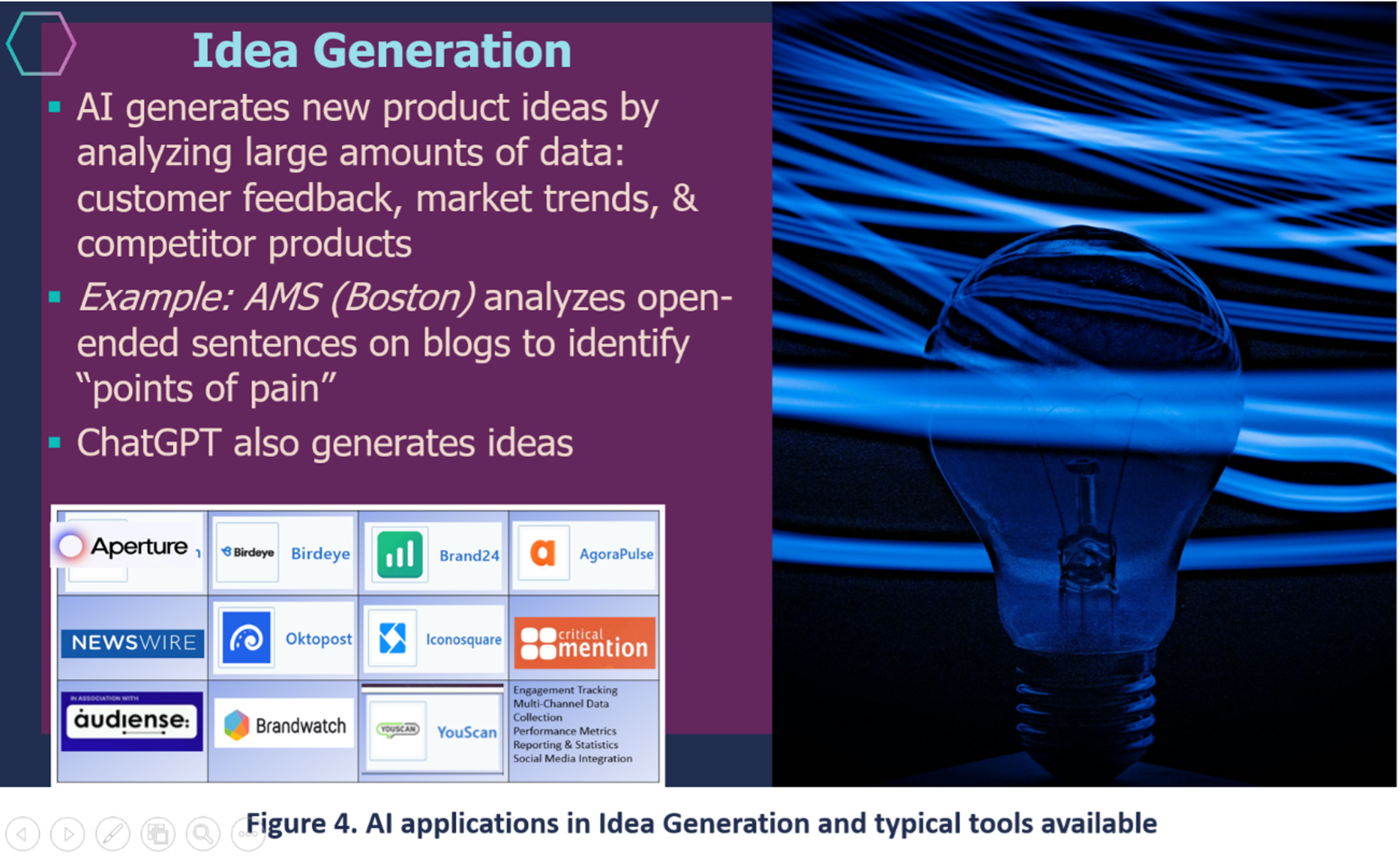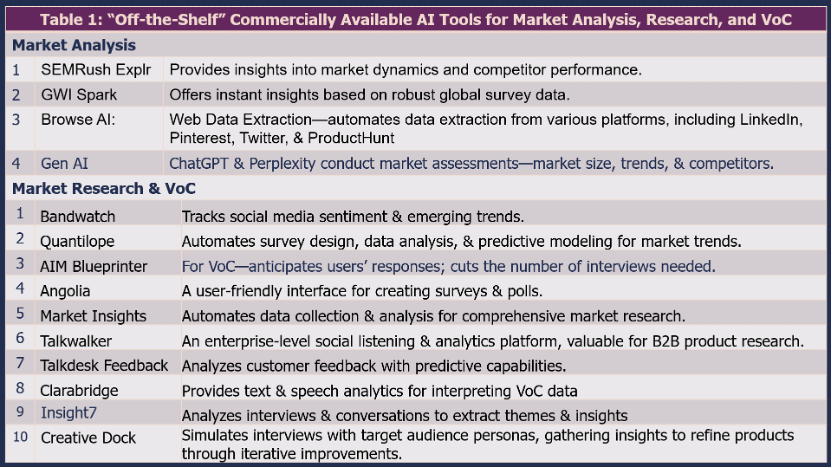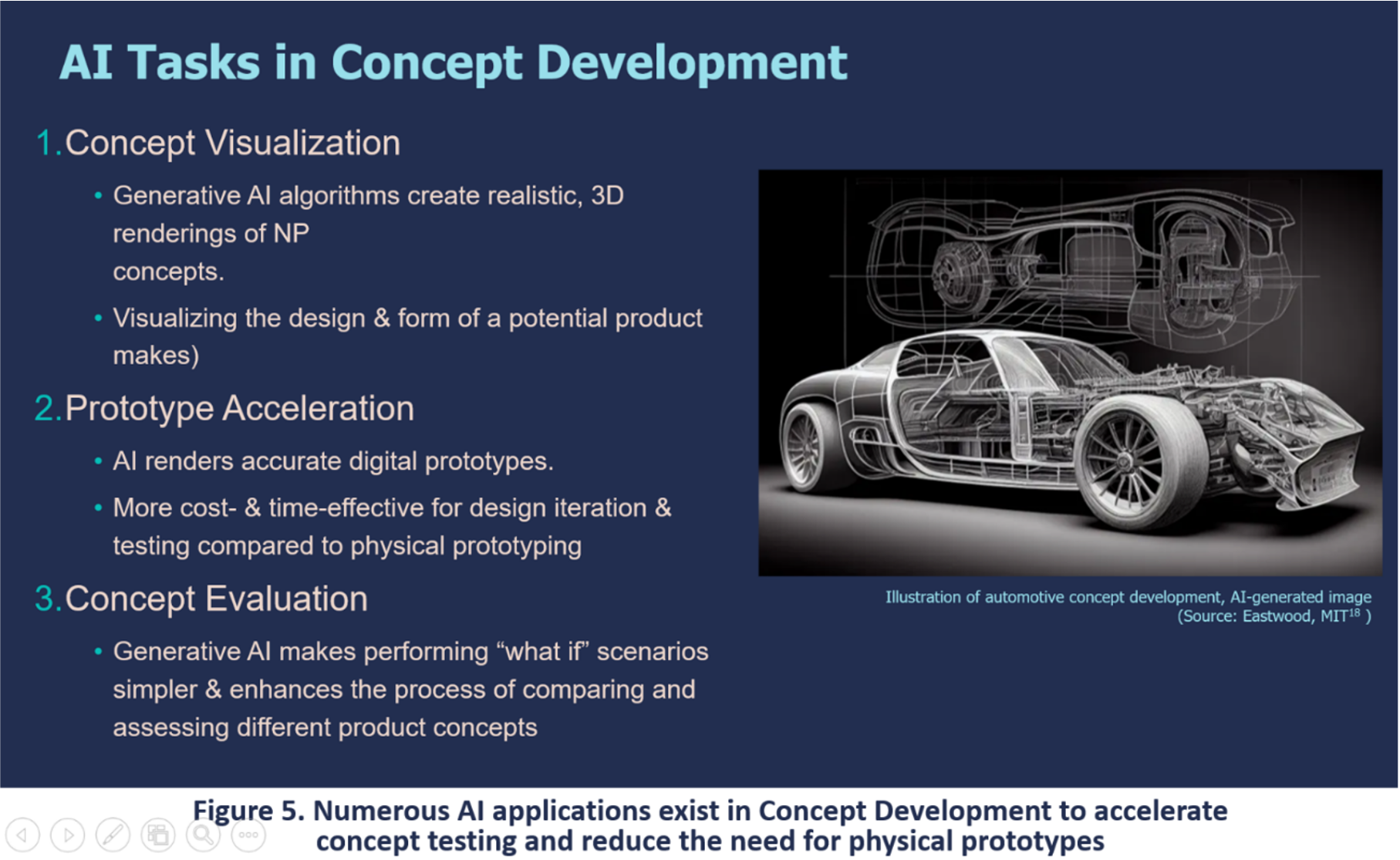For Successful and Accelerated AI Adoption and Results,
Focus on Front End of New Product Development
Dr. Robert G. Cooper
kHUB post date: August 2025
Watch time: 10 minutes
WATCH VIDEO

The Challenge
Artificial intelligence (AI) is making its mark a new product development (NPD). Leading firms such as Siemens, GE, GM, BASF, and Nestlé have already reported significant gains: faster development cycles, stronger product designs, and more effective innovation [1]. Yet these early adopters—with their large IT departments and deep pockets—are not representative of most companies. For the majority, AI adoption in NPD remains a challenge.
Robert G. Cooper, “The Artificial Intelligence Revolution in New Product Development,” IEEE Engineering Management Review 52(1), (Feb. 2024): 195–211. DOI: 10.1109/EMR.2023.3336834 Link: Robert G. Cooper - Artificial Intelligence in NPD (article #1).

Our recent study of U.S. and German firms revealed that adoption rates averaged just 5% for AI across 13 core NPD activities from idea generation to pre-launch product testing—see Figure 1 [2], Further, only 22.7% of firms had implemented even one AI tool for these 13 core activities. These data highlight a sobering reality: while AI has the potential to revolutionize product development, most organizations are still sitting on the sidelines.
What drives the firms that are further ahead? Readiness factors like “executive sponsorship” and “leadership commitment” matter. But the single strongest driver of extensive AI use is having demonstrated positive results from early installations—the red bars in Figure 2.
Unfortunately, very few companies have reached that point: in our study, only 5% saw “demonstrated results” from AI in NPD (the blue bars in Figure 2). And in none of the companies were managers ready to hand critical decisions to AI—trust is lacking.
Broader industry data help explain why. A recent MIT study reveals that 95% of AI projects fail: “About 5% of AI pilot programs achieve rapid revenue acceleration; the vast majority stall, delivering little to no measurable impact on P&L”, largely due to flawed enterprise integration [3]. Similarly, Gartner reports that just 53% of AI projects make it from prototype into production [4] This phenomenon, called pilot paralysis, leaves organizations with stranded AI investments that never reach scale [5]. Other estimates place AI deployment project failure rate at 80%, roughly double that of conventional IT projects [6].
Why AI Adoption Projects Fail

To date, no large-scale, comprehensive studies have pinpointed the precise reasons why AI adoption projects in NPD fall short. However, the limited research available, reinforced by expert insights, highlights a familiar set of failure causes [7]. In order of importance, these are:
- Poor data quality
- Failure to understand users’ needs
- Lack of a change management program
- Unrealistic expectations
- Talent shortages
- The AI solution did not work
- A lack of a cross-functional deployment team (a technical-only AI Ops team was used).
Fortunately, each of these failure reasons can be anticipated and addressed. The first step is to recognize them clearly and then to embed mitigating measures within the firm’s AI adoption and deployment process, if the firm has such a process. A second step is to select AI adoption initiatives that are inherently less vulnerable to failure—for example, simpler AI applications that require less data, where user needs are well defined, and where proven, commercially available solutions already exist. Adoption of AI tools from AI specialized vendors “succeed about 67% of the time, while internal builds succeed only one-third as often” [3].
So how do we break this cycle of failure and frustration? The answer lies in the fuzzy front end (FFE) of innovation.
Look to The Fuzzy Front End
If “demonstrated results” are the strongest catalyst for broader AI use, then companies need some quick AI wins: low-risk, lower-cost, fast AI application projects that deliver visible impact. The fuzzy front end (FFE) is an excellent place to find them.

The FFE encompasses activities from idea generation through to the development stage, as in Figure 3 [8]. Most of the critical project decisions are made here: product concept, target market, positioning, and technical approach. As the PDMA Handbook famously notes, the game is often “won or lost in the first five plays." [9]
The FFE is also where many preventable mistakes occur. Studies consistently identify the causes of new product failure to be a lack of understanding of customer needs, weak or absent market research, and unstable product definitions. In too many projects, essential FFE tasks are under-resourced or skipped entirely [9].
AI offers a compelling remedy. Think of AI as an “Army of Interns”—a tool that provides project teams with scalable support to tackle vital front-end work, faster and often more effectively than traditional approaches. The FFE is also the lowest-cost, lowest-risk area in which to adopt AI, making it a pragmatic starting point for organizations new to AI-enabled NPD.
Below are pragmatic and concrete AI applications in the FFE—where and how AI helps.
AI Applications in the Fuzzy Front End
Idea Generation: AI can scan vast, messy datasets—customer reviews, open-ended survey responses, online user forums and blogs, patent abstracts, market reports, and competitor materials—to surface unmet needs and spark novel concepts. For example, Applied Marketing Science (AMS) analyzes thousands of open-ended online statements to identify consistent “points of pain” [10]. This type of need-mining has led to viable product concepts in categories as diverse as medical devices and commercial snowplows (Figure 4).

Generative AI (e.g., ChatGPT) is also surprisingly capable at ideation when guided by strong prompts and constraints. In comparative tasks, ChatGPT has produced ideas rated more novel than those from human teams using classic methods like brainstorming or TRIZ—especially when the prompts specify the user, context-of-use, constraints, and evaluation criteria [11]. Practical tips include: seed the model with contrasting use scenarios; ask for multiple, independent idea sets; require justification (why this works for this user); and then let AI do the initial screening by ranking ideas against explicit criteria (feasibility, distinctiveness, value). A case study example of AI ideation and idea screening is illustrated in my EMR article for variable-speed industrial pumps [8].
Finally, an expanding list of commercial ideation tools use AI to generate, cluster, and prioritize ideas (see Figure 4 for sample tools). These tools vary in how they source data and score opportunity spaces; the common thread is speed and coverage.
Market Analysis and Voice of Customer (VoC) Research: AI can compress weeks of research into hours. AI helps teams sift through massive volumes of data, identifying emerging trends, segmenting markets, and predicting product viability. Natural language processing tools mine reviews, surveys, and social media to uncover customer needs and preferences.
Generative AI helps teams explore the user’s perspective: it can list jobs-to-be-done, user pains, and desired outcomes for a defined persona in a specific usage context, then contrast those across segments. For structured analysis, ChatGPT drafts a PESTEL assessment tailored to a product and geography, highlighting plausible regulatory shifts, technology enablers, and adoption barriers [12].
In VoC research, AI accelerates both preparation and synthesis. It can generate first-draft interview guides and discussion flows, propose probing questions by segment, and then analyze unstructured data—reviews, transcripts of interviews, free-text surveys, blogs—to extract themes, quality-of-experience drivers, and language customers actually use.
Purpose-built B2B tools such as AIM’s Blueprinter® anticipate likely customer VoC responses and cut the number of interviews in half without sacrificing knowledge gained [13]. The net effect is better VoC coverage, less recall bias, and clearer problem-framing before development begins. Other commercially available AI tools for market analysis and research are shown in Table 1.

Competitive Intelligence: Monitoring competitor activity is critical but resource-intensive. AI-powered tools such as Crayon, SEMRush, and Klue continuously track product launches, pricing changes, and market moves, offering real-time insights into competitive positioning.
Generative AI tools like ChatGPT and Perplexity can even conduct structured competitive analyses on demand; such a competitive analysis was done for a case study on variable speed pumps; AI identified the five main global competitors, the features of their variable speed pumps, and gave an assessment as to whether the proposed new product was differentiated sufficiently [8].
Technical Assessment: Early technical due diligence is often uneven, yet this is where hidden risks lurk. For example, underestimating technical risks or overestimating the firm’s technological capabilities often leads to roadblocks and delays later in the Development stage.
AI helps in the technical assessment by providing real-time insights into technology trends, patent landscapes, and investment flows. ChatGPT, for example, provides technical expertise across unfamiliar domains, generates tailored research plans, and rapidly compiles subject-specific statistics.
Generative AI, such as Perplexity Pro, undertakes a suitable technical assessment pre-Development. AI permits the project team to ask the tough technical questions and find credible answers faster: What is the likely technical solution? What's the magnitude of the technical gap—new science and invention, or simply an engineering repackage? What are the main technical risks? What's the likelihood of technical feasibility? (See example in [8]).
Commercially available AI software also delivers real-time insights on technology trends, investment activities, and market disruptions caused by emerging technologies. Generative AI can review public literature, patents, and standards to summarize state-of-the-art options and even outline experiment plans.
Concept Development: Through advanced concept visualization as illustrated in Figure 5, AI generates realistic 3D renderings that allow project teams and management to visualize potential product designs with unprecedented clarity. These AI-generated 3D concepts serve as the foundation for accurate digital prototypes and digital twins, enabling comprehensive testing using virtual products within simulated user environments [14]. This virtual prototyping approach delivers significant advantages over traditional physical prototyping—dramatically reducing both costs and development timelines while facilitating rapid design iterations.


AI's concept evaluation capabilities further accelerate decision-making through sophisticated "what if" scenario modelling, enabling teams to efficiently compare multiple product alternatives. General Motors exemplifies this approach through its collaboration with MIT, leveraging AI to both develop and test product concepts by predicting consumer preference [15]. While traditional auto concept testing required physical prototypes and extensive consumer focus groups, GM's AI-driven methodology achieves faster, more cost-effective results—with product designs demonstrating 43% higher consumer acceptance rates.
Building the Business Case: Synthesizing insights from multiple FFE activities into a cohesive business case is a complex task where AI excels. Specialized AI platforms—including Upmetrics, 15 Minute Plan, and My Business Case Hub—now automate business case development.
My Business Case Hub, for instance, guides project teams through strategic questioning, then rapidly produces comprehensive, professionally structured business cases within minutes. Similarly, Upmetrics functions as an AI-powered writing assistant that generates compelling content while providing accurate forecasting through intelligent revenue and expense projections. Even general-purpose tools like ChatGPT can generate effective business case documentation.
Go-to-Development Decision: While NPD managers remain cautious about delegating decision-making authority to AI—unlike their Finance counterparts who routinely employ AI for stock trading decisions—AI can significantly enhance decision quality. Advanced AI systems, such as AI-PRISM, now generate success probability predictions for new products, providing crucial data for calculating Expected Commercial Value (ECV) and informing critical Go/No-Go decisions [16].
The Way Forward
More than 40 different AI applications exist for NPD, more than half in the front end shown in Figure 6 [1]. Here, AI has the potential to make the fuzzy front end much less fuzzy. It brings speed, rigor, and creativity to the tasks that shape project outcomes, helping teams avoid costly mistakes and accelerate time to market.
AI adoption must be strategic. Experts caution against piecemeal AI tool acquisition. Instead, once senior management commits to adopting AI, the firm should assemble a cross-functional AI Task Force; their tasks are to assess their NPD process, identify activities where AI adds the most value, and prioritize AI deployment projects that promise to be quick wins. Understanding user needs and ensuring integration with existing processes is critical. Frameworks such as the RAPID process, described in kHUB, provide a structured pathway for AI adoption [17].
For managers, the key takeaway is this: AI applications in the FFE offer fast wins, tangible results, and a foundation for broader AI deployment. By leveraging AI here, organizations can build trust, demonstrate value, and pave the way for more ambitious AI-enabled innovation.
About the Author
Dr. Robert Cooper, Crawford Fellow of Product Development & Management Association, Professor Emeritus, McMaster University, Canada, ISBM Distinguished Research Fellow at Penn State University, and Honorary Advisor, Snyder Innovation Management Center, Syracuse University. A world expert in the field of management of new product development and product innovation, Dr. Cooper has written 10 books on the topic and more than 170 articles. Bob is the creator of the globally-employed Stage-Gate® process used to drive new products to market. He is a noted consultant and advisor to Fortune 500 firms, and also gives public and in-house seminars globally.
LinkedIn: (26) Dr. Robert G. Cooper | LinkedIn
Website: Robert G. Cooper - Internationally recognized expert in the field of innovation management
References
[1] Robert G. Cooper, “The Artificial Intelligence Revolution in New Product Development,” IEEE Engineering Management Review 52(1), (Feb. 2024): 195–211. DOI: 10.1109/EMR.2023.3336834 Link: Robert G. Cooper - Artificial Intelligence in NPD (article #1).
[2] Robert G. Cooper and Alexander M. Brem, “The Adoption of AI in New Product Development: Results of a Multi-firm Study in the US and Europe,” Research-Technology Management 67(3), (2024), 33–54. DOI: 10.1080/08956308.2024.2324241; and: Robert G. Cooper and Alexander M. Brem. “Insights for Managers About AI Adoption in New Product Development,” Research-Technology Management 67(6), (2024): 39–46. DOI: 10.1080/08956308.2024.2418734. Link: Robert G. Cooper - Artificial Intelligence in NPD (articles #8 and 18).
[3] Sheryl Estrada, “MIT Report: 95% of Generative AI Pilots at Companies are Failing,” Fortune (April 19, 2025). Lin MIT report: 95% of generative AI pilots at companies are failing | Fortune
[4] J. Masci, “AI Has a Poor track Record, Unless You Clearly Understand What You’re Going For,” Industry Week (Jan. 19, 2022). Link: AI Has a Poor Track Record, Unless You Clearly Understand What You’re Going for | IndustryWeek
[5] R. Gregory, “Overcoming Pilot Paralysis in Digital Transformation,” Weatherhead School of Management, Case Western Reserve University (April 27, 2021). Link: Overcoming Pilot Paralysis in Digital Transformation | Weatherhead School of Management | Case Western Reserve University
[6] Iavor Bojinov. “Keep Your AI Projects On Track,” Harvard Business Review Magazine (Nov.-Dec. 2023). hbr.org, Link: Keep Your AI Projects on Track
[7] Robert G. Cooper, “Why AI Projects Fail: Lessons From New Product Development,” IEEE Engineering Management Review, (July, 2024). DOI: 10.1109/EMR.2024.3419268 Link: Robert G. Cooper - Artificial Intelligence in NPD (article #10).
[8] Robert G. Cooper, 2025. "The NPD Game Is Won or Lost in the First Five Plays: How AI Can Help in Product Innovation," IEEE Engineering Management Review, (preprint: February, 2025). DOI: 10.1109/EMR.2025.3540373. Link: Robert G. Cooper - Artificial Intelligence in NPD (article #20).
[9] “The PDMA Handbook of Innovation and New Product Development,” 4th ed., edited by Ludwig Bstieler and Charles H. Noble, Chapter 1: “New Products—What Separates the Winners From the Losers and What Drives Success.” Hoboken, NJ: John Wiley & Sons. Link: The PDMA Handbook of Innovation and New Product Development, 4th Edition | Wiley
[10] Kristyn Corrigan, “Breaking Boundaries: Harnessing AI to Fuel Innovation,” Applied Marketing Science PDMA Webinar (2024). Link: Breaking Boundaries: Harnessing AI to Fuel Innovation | Webinar
[11] Stefano Filippi, “Measuring the Impact of ChatGPT on Fostering Concept Generation in Innovative Product Design,” Electronics, 12(16), (Aug. 21, 2023): 35–35, DOI: 10.3390/electronics12163535. Link: Measuring the Impact of ChatGPT on Fostering Concept Generation in Innovative Product Design
[12] Volker Bilgram and F. Laarmann, “Generating Innovation with Generative AI: AI Augmented Digital Prototyping and Innovation Methods,” IEEE Engineering Management Review 52(1), (June 2023): 18–25. DOI: 10.1109/EMR.2023.3272799 ; and: Jan Joosten, Volker Bilgram, Alexander Hahn, and Dirk Totzek, “Comparing the Ideation Quality of Humans With Generative Artificial Intelligence,” IEEE Engineering Management Review 52(2), (April 2024): 153–164. DOI: 10.1109/EMR.2024.3353338
[13] Dan Adams, “Accelerate VOC interviews With AI (and 6 Other Tips),” The AIM Institute (Dec. 1, 2023). Link: Target Customer Needs and Win - The AIM Institute
[14] Siemens. “Airplane Manufacturer Uses Siemens Solutions to Reduce Product Development Time for All-electric Composite Aircraft,” Siemens website case study (2023). Link: Airplane manufacturer uses Siemens solutions to reduce product development time for all-electric composite aircraft | Siemens | Siemens Software
[15] Brian Eastwood, “Artificial Intelligence Can Help Design More Appealing Cars,” MIT Management Sloan School (March 6, 2023). Link: https://mitsloan.mit.edu/ideas-made-to-matter/artificial-intelligence-can-help-design-more-appealing-cars
[16] Robert G. Cooper, “AI-PRISM: A New Lens for Predicting New Product Success,” PDMA kHUB, (Feb. 2025). Link: AI-PRISM: A New Lens for Predicting New Product Success - Knowledge Hub 2.0
[17] Robert G. Cooper, “Adopting Artificial Intelligence for New Product Development: The RAPID Process,”PDMA kHUB, (August 2024). Link: https://community.pdma.org/knowledgehub/bok/product-innovation-process/adopting-artificial-intelligence-for-new-product-development-the-rapid-process